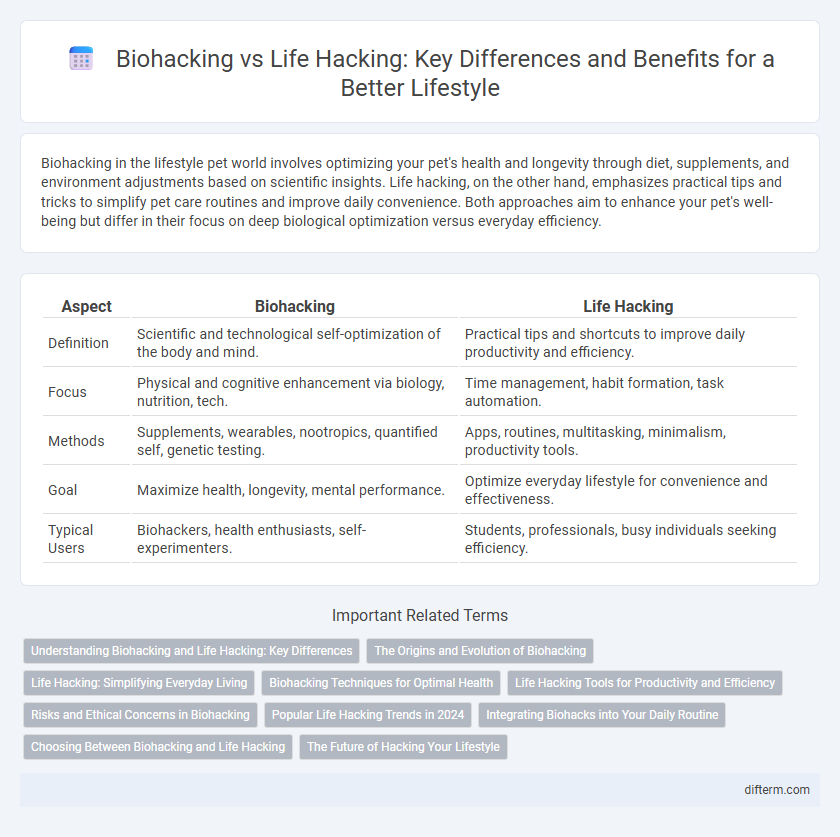Biohacking in the lifestyle pet world involves optimizing your pet's health and longevity through diet, supplements, and environment adjustments based on scientific insights. Life hacking, on the other hand, emphasizes practical tips and tricks to simplify pet care routines and improve daily convenience. Both approaches aim to enhance your pet's well-being but differ in their focus on deep biological optimization versus everyday efficiency.
Table of Comparison
| Aspect | Biohacking | Life Hacking |
|---|---|---|
| Definition | Scientific and technological self-optimization of the body and mind. | Practical tips and shortcuts to improve daily productivity and efficiency. |
| Focus | Physical and cognitive enhancement via biology, nutrition, tech. | Time management, habit formation, task automation. |
| Methods | Supplements, wearables, nootropics, quantified self, genetic testing. | Apps, routines, multitasking, minimalism, productivity tools. |
| Goal | Maximize health, longevity, mental performance. | Optimize everyday lifestyle for convenience and effectiveness. |
| Typical Users | Biohackers, health enthusiasts, self-experimenters. | Students, professionals, busy individuals seeking efficiency. |
Understanding Biohacking and Life Hacking: Key Differences
Biohacking involves scientifically optimizing the body and mind through methods like nutrition, supplements, and technology to enhance physical and cognitive performance. Life hacking focuses on improving daily routines and productivity using simple strategies and tools to simplify tasks and save time. The key difference lies in biohacking's emphasis on biological and physiological modifications, while life hacking targets behavioral efficiency and task management.
The Origins and Evolution of Biohacking
Biohacking originated in the early 2000s when DIY biology enthusiasts began experimenting with body and brain optimization using technology and nutritional science. The evolution of biohacking incorporates biotechnology, neurofeedback, and quantified self methods, distinguishing it from life hacking, which centers on productivity and personal efficiency techniques. Both philosophies seek improvement, yet biohacking emphasizes physiological enhancement through empirical data and scientific interventions.
Life Hacking: Simplifying Everyday Living
Life hacking focuses on practical techniques and tools that streamline daily routines to maximize efficiency and reduce stress. By leveraging simple strategies such as time management apps, decluttering methods, and habit tracking, individuals can significantly improve productivity and overall well-being. This approach emphasizes actionable changes over complex scientific interventions, making it accessible for anyone seeking to simplify everyday living.
Biohacking Techniques for Optimal Health
Biohacking techniques for optimal health include practices such as intermittent fasting, personalized nutrition, and sleep optimization, which aim to enhance physical and cognitive performance. Utilizing wearable technology to monitor biometric data allows for precise adjustments in lifestyle habits that promote longevity and mental clarity. Integrating nootropics and mindfulness exercises further supports cellular regeneration and stress reduction, driving holistic well-being.
Life Hacking Tools for Productivity and Efficiency
Life hacking tools for productivity and efficiency focus on practical methods and apps designed to optimize daily routines and workflows. Popular tools include task management apps like Todoist, time trackers such as Toggl, and automation platforms like Zapier, which streamline repetitive tasks and enhance focus. These tools empower users to maximize output by organizing priorities, minimizing distractions, and automating mundane activities, leading to noticeable improvements in work-life balance and performance.
Risks and Ethical Concerns in Biohacking
Biohacking involves modifying biological systems, which carries risks such as unintended health consequences, genetic mutations, and immune reactions, raising significant safety concerns. Ethical issues arise from biohacking's potential to exacerbate social inequalities, lack of regulatory oversight, and questions about consent, especially in experimental procedures. In contrast, life hacking primarily focuses on productivity and efficiency improvements with minimal physical risks or ethical dilemmas.
Popular Life Hacking Trends in 2024
Popular life hacking trends in 2024 emphasize digital detox techniques, productivity apps, and minimalism strategies that optimize time management and mental well-being. Biohacking, in contrast, focuses on personalized health optimization through wearable technology, nootropic supplements, and quantified self-tracking methods. Both approaches enhance lifestyle efficiency, but life hacking leans towards practical everyday solutions while biohacking integrates scientific and technological interventions for holistic body and mind enhancement.
Integrating Biohacks into Your Daily Routine
Integrating biohacks into your daily routine enhances physical and mental performance through targeted techniques like intermittent fasting, nootropic supplementation, and optimized sleep patterns. Unlike life hacking's focus on productivity and efficiency, biohacking centers on improving overall health biomarkers such as heart rate variability and cognitive function. Consistent application of wearable technology data and personalized nutrition plans makes biohacking a scientifically-driven approach to lifestyle optimization.
Choosing Between Biohacking and Life Hacking
Choosing between biohacking and life hacking depends on personal goals and desired outcomes; biohacking focuses on optimizing physical and mental performance through scientific techniques and technology, such as nootropics and wearable devices. Life hacking emphasizes practical strategies to improve productivity and daily routines, including time management apps and habit-forming techniques. Evaluating individual needs for health optimization versus efficiency improvements helps determine the best approach for enhancing overall lifestyle quality.
The Future of Hacking Your Lifestyle
Biohacking leverages scientific methods and technology to optimize physical and cognitive performance, while life hacking focuses on practical strategies to improve everyday efficiency and well-being. Emerging trends in biohacking include personalized nutrition based on genetic testing, wearable health monitors, and neuroenhancement techniques, shaping a future where lifestyle optimization becomes highly individualized. Integrating both approaches promises a holistic transformation in how people enhance productivity, health, and happiness through data-driven and mindful practices.
biohacking vs life hacking Infographic

 difterm.com
difterm.com